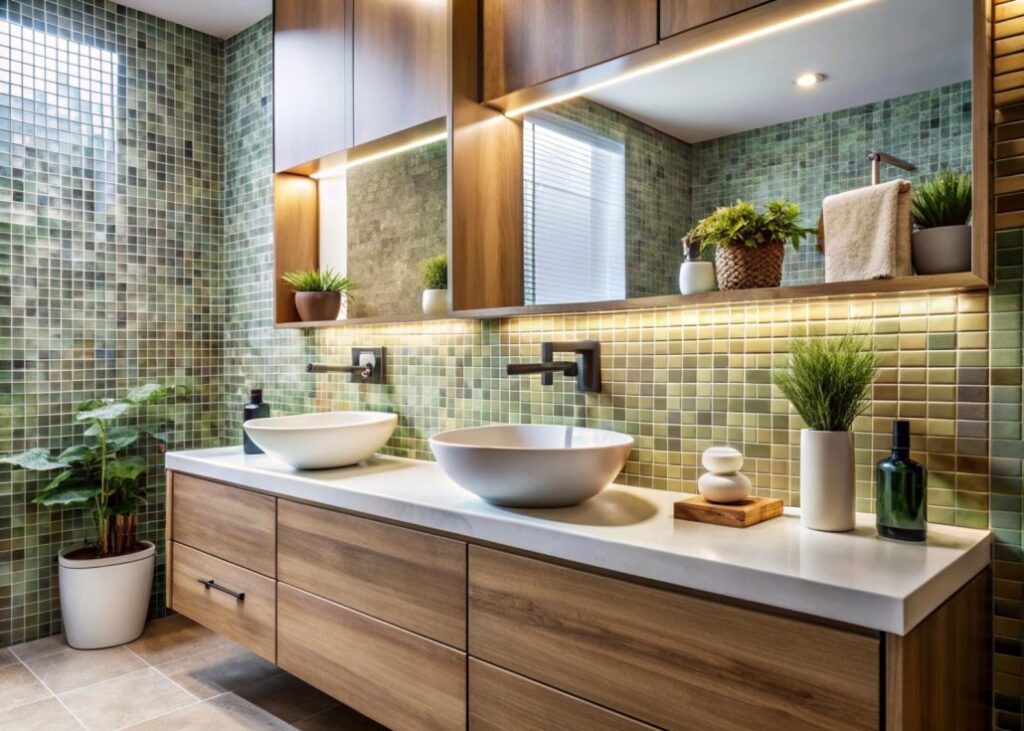
Bathroom Sustainability for Beginners: A Guide to Eco-Friendly Practices
In today’s world, sustainability is more than just a buzzword; it’s a necessity. Whether you’re a seasoned environmentalist or someone new to the concept, understanding bathroom sustainability for beginners is crucial. Bathrooms are one of the most resource-intensive spaces in our homes, making them an ideal starting point for anyone looking to reduce their ecological footprint.

Why Focus on the Bathroom?
The bathroom is often overlooked when it comes to sustainable living. However, given its high water and energy usage, it’s a prime target for eco-friendly improvements. By making small changes, we can significantly impact our planet’s health and conserve precious resources.
Understanding Water Usage
Water is one of the most crucial elements in our homes, yet it’s often wasted in the bathroom. From showers to toilets, water usage can be optimized. Consider installing water-saving devices like low-flow showerheads and dual-flush toilets to minimize water waste. For more tips, you can check how to reduce toilet water waste.
Installing a Low-Flow Showerhead
One of the simplest ways to save water is by installing a low-flow showerhead. These devices reduce water flow without compromising on pressure, offering a satisfying shower experience while conserving water.
Upgrading to a Dual-Flush Toilet
Dual-flush toilets provide two flushing options, allowing you to use less water for liquid waste. This simple upgrade can significantly cut down on your household’s water consumption. Consider upgrading old toilets to smart toilets for even greater efficiency.
Energy Efficiency in the Bathroom
Beyond water savings, energy efficiency is another critical aspect of bathroom sustainability. Lighting, ventilation, and water heating systems can all be optimized for better energy use.
Switching to LED Lighting
LED lights are more efficient and longer-lasting than traditional bulbs. By switching to LEDs, you can save energy and reduce your electricity bills.
Improving Ventilation Systems
Proper ventilation is essential for maintaining air quality and preventing mold growth. Energy-efficient fans use less power and can be timed to run only when necessary. Learn more about creating an eco-friendly bathroom.
Choosing Sustainable Materials
Sustainable materials not only enhance the aesthetic of your bathroom but also reduce environmental impact. Opt for materials like bamboo, recycled glass, and reclaimed wood for a greener choice.
Benefits of Bamboo
Bamboo is a fast-growing, renewable resource that makes an excellent choice for flooring and cabinetry. Its durability and natural beauty add warmth and elegance to any bathroom.
Using Recycled Glass
Recycled glass tiles are both stylish and sustainable. They come in a variety of colors and patterns, offering endless design possibilities. For more inspiration, visit this eco-friendly remodeling checklist.
Eco-Friendly Products and Practices
Incorporating eco-friendly products into your bathroom routine can further enhance its sustainability. From natural cleaning products to biodegradable toiletries, there are numerous options to explore.
Natural Cleaning Products
Harsh chemicals in cleaning products can harm the environment and your health. Choose natural, biodegradable cleaners to keep your bathroom sparkling without the negative side effects.
Biodegradable Toiletries
Toiletries like soap, shampoo, and toothpaste can be found in biodegradable packaging or made from natural ingredients, reducing waste and pollution.
Monitoring and Maintenance
Regular maintenance and monitoring are key to sustaining an eco-friendly bathroom. Install a bathroom leak sensor to prevent water wastage and ensure your fixtures are in good working order.
Checking for Leaks
Leaks can result in significant water loss over time. Regularly inspect your bathroom fixtures for leaks and address them promptly.
Regular Fixture Maintenance
Proper maintenance of faucets, toilets, and showers ensures they operate efficiently, saving water and energy.
Conclusion
Starting your journey towards bathroom sustainability can seem daunting, but with these beginner-friendly tips, you’ll be on your way to making a positive impact. By focusing on water and energy efficiency, choosing sustainable materials, and adopting eco-friendly practices, we can create a healthier planet for future generations.

FAQs
What is the most water-efficient toilet?
Dual-flush toilets are among the most water-efficient options, allowing users to choose between a full or half flush depending on the waste.
How can I make my bathroom more energy-efficient?
Switch to LED lighting, install energy-efficient ventilation fans, and consider a tankless water heater to reduce energy consumption.
Are natural cleaning products effective?
Yes, natural cleaning products are effective and safer for both the environment and your health, offering a sustainable alternative to harsh chemicals.
This article contains affiliate links. We may earn a commission at no extra cost to you.